Scientists and students have been coming across fascinating sci-fi fictional technology and then actually doing the work to make it real.
It can be overwhelming to make this realization, but we’re now actually living in the future that science fiction books and films have been telling us about for so long. And for the most part, these authors and filmmakers did a pretty decent job of predicting what the future might hold for us — technologically speaking.
For every laughably off-base sci-fi prediction (flying cars, memory implants, alien interaction, the list goes on), there’s one that’s almost eerily on the mark. Even fairy tales and fantasy stories from centuries ago will get it right every so often. It’s a stretch, but we can call the magic mirror in “Beauty and the Beast” an 18th-century predecessor of Face Time and Skype (video chatting).
The magic mirror and its sort are more wishful thinking or lucky guesses than anything else. There’s obviously no way that anyone in the 1700s or earlier had even a hint of real technological knowledge about electricity, let alone smartphones. But later on, as science fiction came into its own as a genre and authors developed serious scientific knowledge and interest in technology, the fictional versions of the future started to get more accurate. Many authors and filmmakers collaborated with or fact-checked their theories with scientists, making their work all the more accurate.
You’d be excused for getting sci-fi fever these days when you confront the mass of new technologies that are constantly appearing around us. In Edward Bellamy’s 1888 utopia, the protagonist falls asleep in 1887 and wakes up in 2000 to find cards are used as money like today’s atm/credit cards. The movement-controlled Xbox Connect also harks back to the Tom Cruise film. Stanley Kubrick’s “2001: A Space Odyssey,” although it does have its fair share of clunky misses, is loaded with now-familiar items: talking computers, e-books, space stations and space shuttles. And landing on Mars! Asimov wrote that by now, we’d have unmanned ships there (check) and a manned expedition in the works (check).
In 2014, the technology exists for — and scientists are actively working on — products that very closely replicate light sabers, Iron Man’s cybernetic helmet, Captain America’s shield, Carrie’s telekinetic powers, Batman’s grappling gun and Harry Potter’s invisibility cloak. Who would’ve thought?
There’s an intriguing flip side to this subject, too: Scientists and students have been coming across fascinating sci-fi fictional technology and then actually doing the work to make it real. Thad Sterner, a lead developer of Google Glass, names “Terminator 2” an early motivation for the project. In 2010, two high school students won the Siemens Competition for an emotion-detecting algorithm inspired by the 2004 film “I, Robot”. And chemical engineering students at Stanford started trying to develop self-healing skin after watching an “X-Men” movie.
These examples are only the tip of the iceberg. There’s probably a group of students at MIT watching “E.T.” right now and deciding to make flying bikes a reality. And only time will tell which other sci-fi predictions will turn out to be true – and which ones we’ll laugh at later.
















